Cornet
 Cornet, valved brass musical instrument that evolved in the 1820s from the continental post horn (cornet-de-poste, which is circular in shape like a small French horn). One of the first makers was the Parisian Jean Asté, known as Halary, in 1828. The tube is conical except through the three valves, tapering gently to a narrow, detachable shank into which the brass mouthpiece is placed. The taper, coupled with the fairly deep, funnel-shaped mouthpiece, imparts a mellowness to the tone and a flexibility to the technique that quickly established the cornet in a leading position in brass and military bands.
Cornet, valved brass musical instrument that evolved in the 1820s from the continental post horn (cornet-de-poste, which is circular in shape like a small French horn). One of the first makers was the Parisian Jean Asté, known as Halary, in 1828. The tube is conical except through the three valves, tapering gently to a narrow, detachable shank into which the brass mouthpiece is placed. The taper, coupled with the fairly deep, funnel-shaped mouthpiece, imparts a mellowness to the tone and a flexibility to the technique that quickly established the cornet in a leading position in brass and military bands.
The “cornett”, a wooden wind instrument with a cup-shaped mouthpiece, appeared in the late 15th century and remained popular for about 200 years, even remaining in use through the end of the 19th To differentiate from the cornet, F. W. Galpin insisted on continuing to spell cornett with the extra “T”.
At four and a half feet long, the cornet is a more compact and shorter instrument than its cousin, the trumpet. When the cornet was invented, nobody bothered to take a patent out on it. It can be traced to Jean-Louis Antoine, however, and was in use throughout Paris by the 1820s. By 1830s, horn player Dufresne performed solos on the cornet at regular gigs.